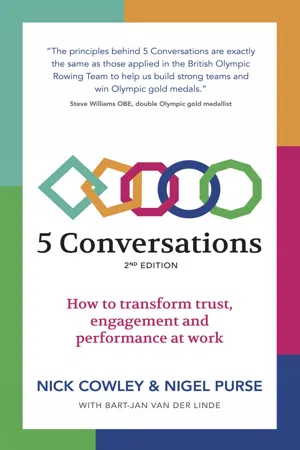
5 Conversations
How to transform trust, engagement and performance at work
Nick Cowley, Nigel Purse, Bart-Jan van der Linde
- 283 pages
- English
- ePUB (mobile friendly)
- Available on iOS & Android
5 Conversations
How to transform trust, engagement and performance at work
Nick Cowley, Nigel Purse, Bart-Jan van der Linde
About This Book
Research shows that successful businesses are those where employees are really engaged. How do they achieve this? Complex organisation initiatives or something more personal? In today's world of work, with all its jargon, processes, KPIs and technology we have forgotten a simple truth: the power of authentic, two-way, human conversations. This book, now in its 2nd edition, comes from over 30 years of learning from world-class organisations, tried-and-tested leadership coaching techniques and emergent thinking on neuroscience and employee behaviour. The result is a simple guide to why, when and how to hold five critical conversations with people you manage, which have been proven to dramatically improve trust, relationships, motivation and performance at work.
Frequently asked questions
Information
Table of contents
- Cover
- Title
- Copyright
- Praise for 5 Conversations
- Acknowledgements
- Foreword
- Preface
- Contents
- Chapter 1: Leadership is relationship
- Chapter 2: Why do conversations matter – the business case
- Chapter 3: Why do conversations matter – the scientific evidence
- Chapter 4: Getting ready to hold the conversations
- Chapter 5: Conversation 1 – Establishing a trusting relationship
- Chapter 6: Conversation 2 – Agreeing mutual expectations
- Chapter 7: Conversation 3 – Showing genuine appreciation
- Chapter 8: Conversation 4 – Challenging unhelpful behaviour
- Chapter 9: Conversation 5 – Building for the future
- Chapter 10: Other ways to use 5 Conversations
- Chapter 11: Conclusion
- Appendix
- About the authors